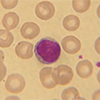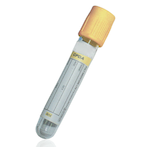
- Home
- Clinical Chemistry Tests
- Caeruloplasmin
Caeruloplasmin
Specimen Volume
1mL blood (~250uL sample).Turnaround Time
24 hoursSample Processing In Laboratory
No special requirementsSample Stability
2 days 2-8°CGeneral Information
Caeruloplasmin is an acute phase and a transport protein. It is a blue-coloured glycoprotein (belonging to the α2-globulin electrophoretic fraction) with 8 copper atoms incorporated into the molecule during synthesis in hepatocytes. Caeruloplasmin is secreted by the liver and migrates to copper requiring tissues where it is liberated. In addition to transporting copper, it has a catalytic function in the oxidation of iron (Fe2+ to Fe3+), polyamines, catecholamines and polyphenols.
Decreased concentrations of caeruloplasmin occur during recessive autosomal hepatolenticular degeneration (Wilson's disease). This disease involves decreased synthesis because defective metallothionine prevents copper incorporation and results in copper deposits in the liver causing cirrhosis, and also in the brain, cornea and kidneys. In the rare genetic Menke’s syndrome, caeruloplasmin is low because of problems with copper absorption. Protein loss syndromes and liver cell failure also depress caeruloplasmin. As caeruloplasmin is an acute phase protein, it can be increased during acute or chronic inflammatory processes.
Patient Preparation
None
Reference Range
0.2-0.6 g/L
Source of Reference Range
Abbott DiagnosticsSpecifications
- EQA Status: UK NEQAS Specific proteins
- EQAS Scheme: Yes
Link to Further Information
http://www.labtestsonline.org.uk/understanding/analytes/caeruloplasmin/tab/testCreation Date
Monday, 08 August 2011Modification Date
Monday, 10 February 2020General Information
Location of Laboratories
Copyright UHB Pathology 2018
Protection of Personal Information – Clinical Laboratory Services comply with the Trust Data Protection Policy and have procedures in place to allow the Directorate and it’s employees to comply with the Data Protection Act 1998 and associated best practice and guidance.
University Hospitals Birmingham medical laboratories at Queen Elizabeth Hospital, Heartlands Hospital, Good Hope Hospital and Solihull Hospital are UKAS (United Kingdom Accreditation Service) accredited to the ISO 15189:2012 standard. For a list of accredited tests and other information please visit the UKAS website using the following link: https://www.ukas.com/find-an-organisation/
- Molecular Pathology is a UKAS accredited medical laboratory No. 8759
- Biochemistry is a UKAS accredited medical laboratory No. 8910
- Haematology and Transfusion is a UKAS accredited medical laboratory No. 8784
- Clinical Microbiology is a UKAS accredited medical laboratory No. 8760
- Cellular Pathology is a UKAS accredited medical laboratory No. 10141
- Musculoskeletal laboratory is a UKAS accredited medical laboratory No. 9897
- Heartlands, Good Hope and Solihull Hospital pathology laboratories are a UKAS accredited medical laboratory No.8217.
Tests not appearing on the UKAS Schedule of Accreditation currently remain outside of our scope of accreditation. However, these tests have been validated to the same high standard as accredited tests and are performed by the same trained and competent staff.
For further test information, please visit the test database: http://qehbpathology.uk/test-database
For further information contact Louise Fallon, Quality Manager, 0121 371 5962
 Biochemistry
Biochemistry Haematology and Transfusion
Haematology and Transfusion Clinical Microbiology (Including Virology)
Clinical Microbiology (Including Virology) Cellular Pathology
Cellular Pathology General Information
General Information Molecular Pathology
Molecular Pathology